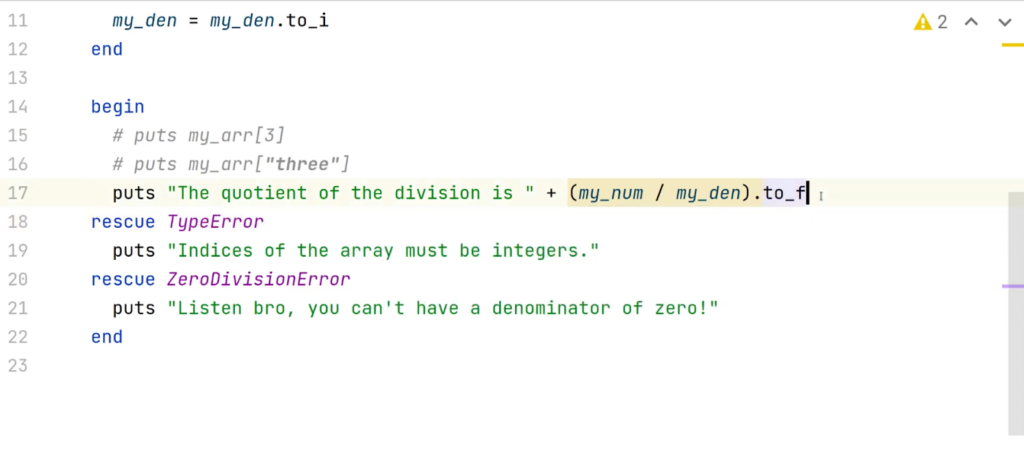Navigating through Ruby’s error messages or “exceptions” is a common challenge for programmers. These interruptions in your code’s flow can arise from various scenarios, such as attempting to access a file that alternates between being present and absent, or dealing with an API whose availability fluctuates due to certain constraints. Occasionally, these exceptions are totally unforeseen.
In this guide, you’ll acquire the skills to effectively handle these anticipated interruptions in your Ruby applications.
Error Handling in Ruby
We’re going to delve into the utilization of two pivotal Ruby keywords: “begin” and “rescue,” which are integral to managing error conditions.
Understanding their mechanism is crucial.
Consider that your Ruby scripts are susceptible to errors during execution, which could stem from several actions, including:
- Accessing a file that doesn’t exist;
- Performing division by zero;
- Interacting with a web server sporting an expired SSL certificate;
- Fortunately, when such errors occur, Ruby doesn’t terminate your program immediately.
Instead, you’re afforded the opportunity to rectify the issue — a process known as “exception handling.”
Ruby provides specific keywords, namely “begin” and “rescue,” to facilitate this process, allowing your code to recover gracefully from such setbacks. Join us as we explore the strategies to harness these keywords effectively!
Understanding and Managing Exceptions in Ruby Programming
Managing exceptions effectively is a crucial aspect of robust Ruby programming. It involves anticipating potential errors and implementing strategies to handle them gracefully. The primary mechanism for this in Ruby is the use of begin and rescue blocks, which provide a structured approach to error handling.
- The Mechanism Explained: At the core of this error-handling strategy is the begin block, where you place the code that has the potential to raise exceptions. This is followed by one or more rescue blocks that define how to respond to specific exceptions, allowing you to maintain control over your program’s flow, even when unexpected issues arise;
- Example Scenario: Consider a situation where you attempt to open a file that doesn’t exist or isn’t accessible:
begin
IO.sysopen('/dev/null')
rescue
# ...
endIn this example, IO.sysopen is used to try and open a file. Should this operation fail (for instance, if the file doesn’t exist), Ruby raises an exception. This is where the rescue block comes into play, allowing you to specify actions to be taken when an exception occurs.
- Handling Exceptions: A practical approach to using the rescue block is not just to catch the exception but to respond in a way that keeps your program running smoothly. For example, logging the error for later review and providing a fallback operation or default value can be a wise choice:
begin
IO.sysopen('/dev/null')
rescue
puts "Can't open IO device."
endBest Practices:
| Best Practice | Description |
|---|---|
| Don’t Ignore Errors | Silently ignoring errors can lead to bigger problems down the line. Always ensure that exceptions are logged or handled in a way that does not obscure the root cause of the problem. |
| Specific Exception Handling | Whenever possible, rescue specific exceptions rather than using a generic rescue block. This helps in writing more precise error-handling code. |
| Ensure Cleanup | Use ensure blocks to clean up resources, such as closing files or network connections, regardless of whether an exception was raised. |
Managing Multiple Error Types
Understanding the versatility of Ruby’s exception handling mechanism is essential for writing robust applications. One of the advanced techniques involves specifying which exceptions you wish to catch in your error-handling code.
So, what are these specifications?
They are essentially the classes of exceptions that your code is prepared to rescue. The specificity of the exception class you rescue can vary greatly depending on the operations your code performs.
For instance, when working with file operations, you might encounter:
- Errno::ENOENT, which signifies a missing file;
- Errno::EACCES, which indicates a permission error.
The effectiveness of Ruby’s exception handling stems from its capability to handle multiple exceptions within a single error-handling construct.
Consider the following example:
begin
IO.sysopen('/dev/null')
rescue Errno::ENOENT
puts "File not found."
rescue Errno::EACCES
puts "Insufficient permissions, not allowed to open file."
endIn this snippet, we’re handling two different exceptions separately, providing a tailored response to each error scenario.
However, Ruby also offers a streamlined approach for handling multiple exceptions that warrant the same response:
begin
IO.sysopen('/dev/null')
rescue Errno::ENOENT, Errno::EACCES
puts "There was an error opening the file."
end
Here, both Errno::ENOENT and Errno::EACCES are rescued in a single line, simplifying the code while maintaining clear and effective error handling.
Handling Exceptions in Ruby Without the Begin Keyword
In Ruby, managing exceptions doesn’t always necessitate the use of the begin keyword. There are specific scenarios where it’s perfectly acceptable to omit it, particularly within methods and blocks. This technique simplifies your code and makes it more readable.
For instance, consider the following method that attempts to open a device:
def get_null_device
IO.sysopen('/dev/null')
rescue Errno::ENOENT
puts "Can't open IO device."
endIn this example, the method itself acts as an implicit begin block, allowing you to directly use rescue to handle exceptions. This eliminates the need for explicit begin and end blocks within the method.
The same principle applies to blocks. Take a look at this code snippet that processes a list of files:
["a.txt", "b.txt", "c.txt"].map do |f|
IO.sysopen(f)
rescue Errno::ENOENT
puts "Can't open IO device: #{f}."
endIn this case, the block provided to map also serves as an implicit begin block, enabling direct exception handling with rescue.
Moreover, Ruby provides additional flexibility in handling exceptions without the begin keyword, further streamlining exception management in your code. Let’s explore how this approach can be utilized effectively.
Inline Exception Handling and Its Pitfalls

Inline exception handling is a technique that can be employed under certain circumstances for succinct code execution. For instance:
Here’s an example:
["a.txt", "b.txt", "c.txt"].select { |f| File.open(f) rescue nil }.map(&:size)This pattern allows for the processing of files that are accessible, omitting any that aren’t, thereby yielding the sizes of only the files that could be opened, without raising exceptions.
The allure here is the convenience of condensing operations into a single line, which may seem appealing for the sake of brevity. However, this approach bears a significant risk. It indiscriminately catches all exceptions that inherit from StandardError, which constitutes the majority of runtime exceptions.
The critical flaw in this method lies in its lack of specificity: it is generally advisable to target precise exceptions for handling, rather than casting a wide net. This specificity helps in avoiding the concealment of unforeseen errors, which could otherwise result in obscure bugs and challenging debugging scenarios.
Conclusion
Mastering exception handling in Ruby with the ‘begin’ and ‘rescue’ keywords is essential for improving your coding abilities. These techniques prevent unexpected program crashes and enable effective error management. By learning to handle multiple exceptions, utilizing ‘rescue’ within blocks and methods, and understanding the drawbacks of inline ‘rescue’, you can develop resilient, professional Ruby programs capable of handling disruptions smoothly and effectively. It’s important to note that errors cannot be entirely eliminated, but knowing how to manage them skillfully is crucial.


